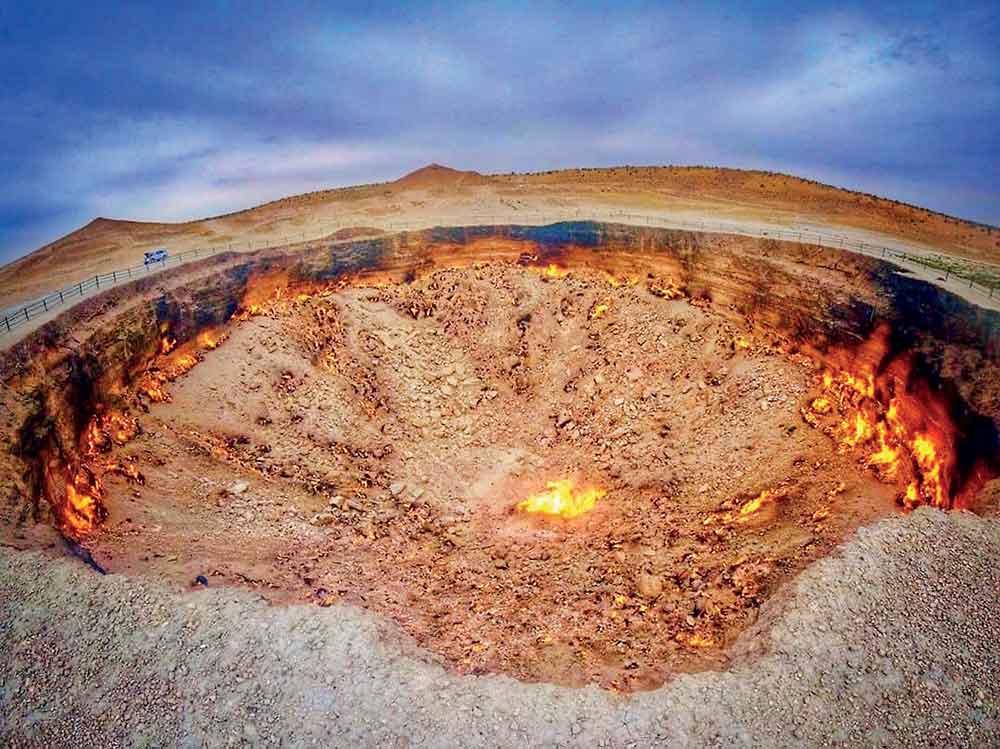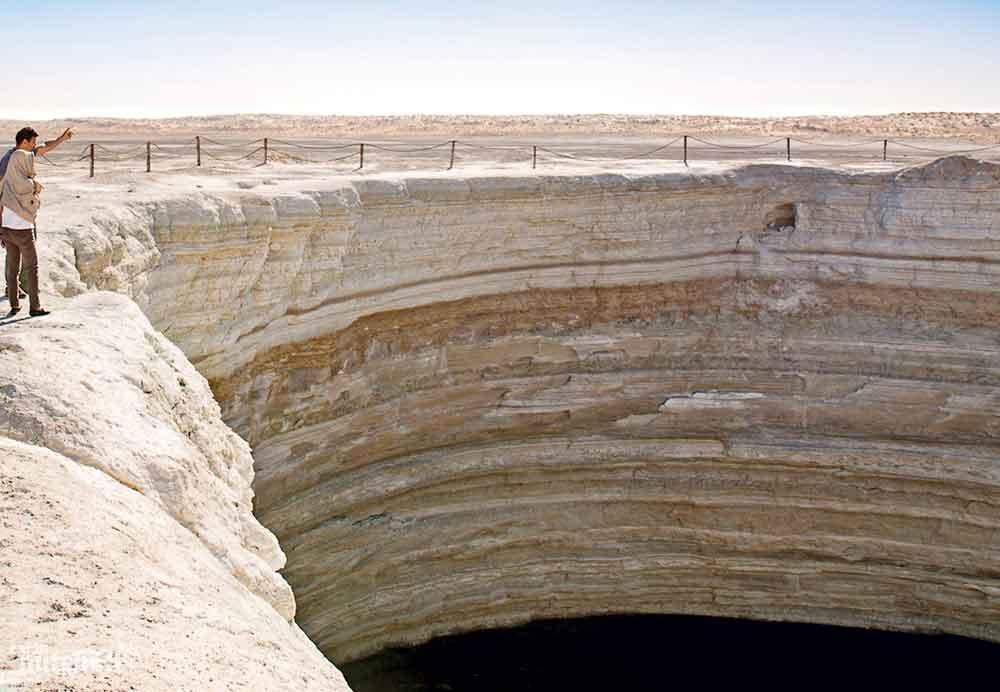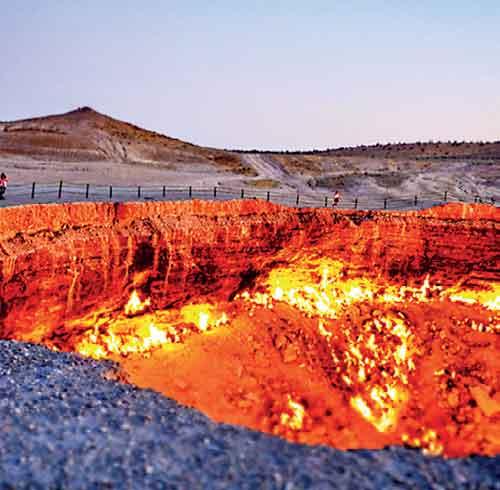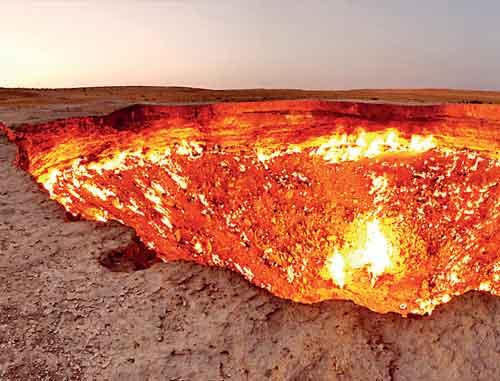
Deep in the heart of the Karakum Desert in Turkmenistan, where the sand stretches endlessly and the heat dances off the horizon, there is a hole in the Earth that has been burning, literally burning for more than 50 years. Locals call it “The Door to Hell.” Scientists call it a gas crater. Tourists call it terrifying. But one thing is certain: you’ve never seen anything like it.
Welcome to Darvaza a remote village with a fiery secret.
Imagine walking through a silent desert under a moonless sky. It’s cold. There’s no wind. Then, out of the darkness, you see a glow in the distance like a campfire from another world.
As you get closer, you feel heat on your skin. Then suddenly, the ground opens up a massive crater, 230 feet wide and 100 feet deep, filled with roaring flames. It’s not a volcano. It’s not a wildfire. It’s just… burning. And no one can turn it off.
This isn’t science fiction. This is the Darvaza Gas Crater. And yes, it’s been on fire since 1971.

The story of the crater’s origin is shrouded in half-truths and mystery, like any good legend. But here’s what we know.
In the early 1970s, when Turkmenistan was part of the Soviet Union, Soviet geologists were drilling in the desert, searching for natural gas. They found what they thought was a large deposit. But when they started drilling, the ground collapsed swallowing their equipment and leaving a gaping hole in the Earth.
Soon after, toxic methane gas began leaking from the crater. The scientists were worried the gas would harm nearby villages or wildlife, so they made a bold decision:
Set it on fire.
They believed it would burn out in a few weeks.
That was over five decades ago.
The fire never stopped.
In the early 1970s, when Turkmenistan was part of the Soviet Union, Soviet geologists were drilling in the desert, searching for natural gas. They found what they thought was a large deposit.
Today, the crater is a spectacle of fire and fury. Thousands of flames leap from the earth, licking the desert air. At night, it glows like a fiery eye staring up at the stars. The heat is so intense, you can’t get too close for long. The air smells faintly of sulfur and scorched rock.
There’s no fence, no warning signs, and no entrance fee. Just you, the fire, and the eerie sound of roaring gas.
In a world full of controlled environments and manicured tourist traps, Darvaza is pure, unfiltered Earth. Raw. Wild. Unapologetic.

Why Doesn’t It Go Out?
The short answer? Natural gas.
Turkmenistan has the fourth-largest natural gas reserves in the world, and Darvaza sits on top of one of them. Every second, invisible gas escapes from the ground and feeds the flames. As long as that gas flows, the fire burns.
Scientists still don’t know how much gas is left underground. Theoretically, it could keep burning for hundreds of years. Or it could stop tomorrow.
But for now? It just keeps going an eternal campfire in the middle of nowhere.
Visiting Darvaza isn’t easy. Turkmenistan is one of the least-visited countries on Earth, with strict visa policies and limited tourism infrastructure. It’s sometimes called the North Korea of Central Asia tightly controlled and highly secretive.
But for the truly adventurous, it’s worth every hurdle.
Today, the crater is a spectacle of fire and fury. Thousands of flames leap from the earth, licking the desert air. At night, it glows like a fiery eye staring up at the stars.
From the capital city of Ashgabat, it takes about 4 to 5 hours by 4x4 to reach the crater. The drive takes you across the blazing Karakum Desert; one of the most barren, windswept regions on the planet. There's no public transportation, no gas stations for miles, and almost no cellphone signal.
But once you arrive and see that fiery pit glowing in the dark, everything fades away.
Most visitors don’t just take a photo and leave. They stay.
Camping near the crater is an unforgettable experience. As the sun sets over the sand dunes, the flames grow brighter, reflecting off the faces of travelers sitting nearby wide-eyed, silent, awestruck.
You cook dinner over the fire. You share stories under the stars. You wake up to the smell of burning gas and the crackling sound of eternal flames.
There’s no hotel, no plumbing, no gift shop. Just you and a geological phenomenon that refuses to die.
What makes this even more fascinating is the contrast with the rest of Turkmenistan.
Ashgabat the capital is a city of white marble buildings, massive golden statues, and eerily empty streets. It holds the Guinness World Record for most white marble buildings in a single city. It's surreal, like a ghost town from the future.
And then there’s Darvaza: no buildings, no statues. Just sand. Silence. And a hole full of fire.
It’s this duality that makes Turkmenistan and especially Darvaza feel like a place out of time.

Will They Shut It Down?
In recent years, there’s been talk of extinguishing the crater.
In 2022, Turkmenistan’s president said he wanted to “put out the fire” citing environmental damage, wasted energy, and safety risks. But as of now, nothing has changed. The flames continue to burn, the tourists continue to arrive, and the legend of the Gates of Hell grows stronger with each passing year.
Some believe the crater should be preserved not just as a geological curiosity, but as a warning. A reminder of what happens when humans try to control nature and accidentally unleash something they can’t stop.

Why Should You Go?
In an age where most places have been photographed, filtered, and turned into hashtags, Darvaza is something else.
There are no crowds. No influencer shoots. No fast-food joints nearby.
Just raw nature, a fascinating backstory, and the humbling feeling of standing at the edge of something older, deeper, and more powerful than yourself.
This isn’t just a fiery hole in the desert.
It’s a mirror reflecting our curiosity, our mistakes, and our endless fascination with the unknown.
We often say we want to see the world, but most of us really mean the same places beaches, cafes, cities.
Comfortable places.
But Darvaza isn’t comfortable. It’s unpredictable. It doesn’t fit into an Instagram grid. It smells like sulfur. It might disappear. And that’s exactly why you should go.
Because sometimes, to feel alive, you have to stand at the edge of the Earth and stare straight into the fire.












